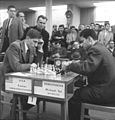Portal:Chess
Introduction
Chess is a board game for two players. It is sometimes called international chess or Western chess to distinguish it from related games such as xiangqi (Chinese chess) and shogi (Japanese chess).
Chess is an abstract strategy game which involves no hidden information and no elements of chance. It is played on a square game board called a chessboard containing 64 squares arranged in an 8×8 grid. The players, referred to as "White" and "Black", each control sixteen pieces: one king, one queen, two rooks, two bishops, two knights, and eight pawns. White moves first, followed by Black; then moves alternate. The object of the game is to checkmate (threaten with inescapable capture) the enemy king. There are also several ways a game can end in a draw.
The recorded history of chess goes back at least to the emergence of a similar game, chaturanga, in seventh-century India. After its introduction in Persia, it spread to the Arab world and then to Europe. The modern rules of chess emerged in Europe at the end of the 15th century, with standardization and universal acceptance by the end of the 19th century. Today, chess is one of the world's most popular games, with millions of players worldwide. (Full article...)
Selected article -
Mikhail Moiseyevich Botvinnik (Russian: Михаи́л Моисе́евич Ботви́нник, romanized: Mikhaíl Moiseyevich Botvínnik) (August 17 [O.S. August 4] 1911 – May 5, 1995) was a Soviet and Russian chess grandmaster who held five world titles in three different reigns. The sixth World Chess Champion, he also worked as an electrical engineer and computer scientist and was a pioneer in computer chess. He also had a mathematics degree (honorary).
Botvinnik was the first world-class player to develop within the Soviet Union. He also played a major role in the organization of chess, making a significant contribution to the design of the World Chess Championship system after World War II and becoming a leading member of the coaching system that enabled the Soviet Union to dominate top-class chess during that time. His pupils include World Champions Anatoly Karpov, Garry Kasparov and Vladimir Kramnik. He is often described as the patriarch of the Soviet chess school and is revered for his analytical approach to chess. (Full article...)
General images
Selected image
FIDE world ranking
| Rank | Player | Rating |
|---|---|---|
| 1 | 2831 | |
| 2 | 2803 | |
| 3 | 2802 | |
| 4 | 2801 | |
| 5 | 2777 | |
| 6 | 2768 | |
| 7 | 2763 | |
| 8 | 2754 | |
| 9 | 2751 | |
| 10 | 2750 | |
| 11 | 2747 | |
| 12 | 2747 | |
| 13 | 2741 | |
| 14 | 2741 | |
| 15 | 2740 | |
| 16 | 2739 | |
| 17 | 2734 | |
| 18 | 2734 | |
| 19 | 2733 | |
| 20 | 2733 |
Top 10 WikiProject Chess Popular articles of the month
Did you know...
- ... that Magnus Carlsen, the current World Chess Champion, resigned a recent tournament game after only one move?
Reviewed articles
Chess from A to Z
| Index: | A B C D E F G H I J K L M N O P Q R S T U V W X Y Z (0–9) |
| Glossary: | A B C D E F G H I J K L M N O P Q R S T U V W X Y Z |
Topics
Subcategories
Related portals
Related WikiProjects
Associated Wikimedia
The following Wikimedia Foundation sister projects provide more on this subject:
-
Commons
Free media repository -
Wikibooks
Free textbooks and manuals -
Wikidata
Free knowledge base -
Wikinews
Free-content news -
Wikiquote
Collection of quotations -
Wikisource
Free-content library -
Wikiversity
Free learning tools -
Wiktionary
Dictionary and thesaurus




















































































